# EMSC 3002 ## Extensional regimes - **Louis Moresi** (convenor) - Chengxin Jiang (lecturer) - Romain Beucher (former lecturer) - Stephen Cox (curriculum advisor) Australian National University _**NB:** the course materials provided by the authors are open source under a creative commons licence. We acknowledge the contribution of the community in providing other materials and we endeavour to provide the correct attribution and citation. Please contact louis.moresi@anu.edu.au for updates and corrections._ <--o--> ## Resources 1. **Fossen, H, 2011.** *Structural Geology.* Cambridge University Press, 2nd Edition. 1. **McClay, K.R. 1991.** *The Mapping of Geological Structures.* John Wiley & Sons. 1. **Park, R.G., 1995.** *Foundations of Structural Geology.* Blackie & Sons Ltd. 1. **Davis, G.H. and Reynolds, S.J., 1996.** *Structural Geology of Rocks and Regions.* 2nd Edition, John Wiley & Sons. <!-- 1. **Hatcher, R.D., 1990.** *Structural Geology - Principles, Concepts, and Problems*, 2nd Edition, Prentice-Hall --> <!-- 1. **Ramsay, J.G. and Huber, M.I. 1983.** *Modern Structural Geology. Volume 1: Strain Analysis.* Academic Press. --> <!-- 1. **Ramsay, J.G. and Huber, M.I. 1987.** *Modern Structural Geology. Volume 2: Folds and Fractures.* Academic Press. --> <--o--> ## Intended learning outcomes The students will learn about the structural style of extensional regimes. <--o--> ## Extensional regimes Extensional faults and shear zones are widespread in most orogenic belts. Current interest is also related to the fact that many hydrocarbon ressources are located in rift settings and are controlled by normal faults. Development of hydrocarbon reservoirs also requires a good understanding of extensional faults. <--o--> ## Tectonic Extension  <!-- .element style="width:50%;float:right; margin-left:50px;" --> Tectonic Extension affects the crust and the upper (lithospheric) mantle. Tectonic Extension refers to the process of crustal scale extension in the horizontal plane. In the brittle part of the crust (upper 10-15km) tectonic extension is accommodated by **normal faulting**. In the lower part of the crust and the upper part of the mantle, tectonic extension is accommodated along **low-angle shear zones**. *Northern North Sea rift system, Haakon Fossen* <--o--> ## General definition  <!-- .element style="width:50%;float:right; margin-left:50px;" --> **Extension** describe the increase in distance between two points. **Elongation** ($e$) is defined as: $$e = (l-l_0)/l_0$$ We usually expressed extension using the beta ($\beta$) factor which is defined as: $$\beta = l/l_0 = 1 + e$$ <--o--> ## General definition ### Principal stresses orientation and extension  <!-- .element style="width:50%;float:left" -->  <!-- .element style="width:50%;float:right" --> <--o--> ## Extensional Faults  <!-- .element style="width:30%;float:right; margin-left:50px;" --> Extensional faults causes extension of the crust or of some reference layer. Remember that **Tectonic Extension** is mainly horizontal. Reverse fault can accommodate **local extension**, not horizontally, but for example parallel to tilted beds. Extensional faults orientations cover a spectrum ranging between **vertical faults** and **horizontal faults**. The orientation of the extensional faults influence the magnitude of the extension. <--o--> ## Extensional Faults ### Domino fault systems  <!-- .element style="width:30%;float:right; margin-left:50px;" -->  <!-- .element style="width:30%;float:right; margin-left:50px;" --> **A series of rigid fault blocks that rotate simultaneously in a uniform sense** The domino model has the following properties: - No internal block deformation - Faults and fault blocks rotates simultaneously, in the same sense and at the same rate. - Throw across the domino faults is identical. <--o--> ## Extensional Faults ### Domino fault systems: Example of te Statfjord formation  <!-- .element style="width:90%" --> The Western part of the Gullfacks Field in the northern North Sea has been intrepreted as a domino system. However, the blocks show significant internal deformation. *Modified after Fossen & Hesthammer (1998)* <--o--> ## Extensional Faults ### How do domino systems form? It is unclear how exactly domino systems form. Many domino systems rest on low-angle (<30 degrees detachments) that nucleate in mechanically weak zones (e.g. clay, salt). Rotation of strata prior to faulting can sometimes explain domino systems.  <!-- .element style="width:50%;float:left" -->  <!-- .element style="width:50%;float:right" --> <--o--> ## Extensional Faults ### Graben and Horst systems  <!-- .element style="width:50%;float:right; margin-left:50px;" --> Arrays of oppositely dipping normal faults that accomodate horizontal extension. In the ideal model, the growth rates of the faults are equal so no rotation or internal deformation occurs within the blocks. <--o--> ## Extensional Faults ### Normal Fault systems  <!-- .element style="width:50%;float:right; margin-left:50px;" --> **Conjugate fault sets** Some Definitions: **Antithetic**: in a direction opposite to the prevailing sense of vergence (Sense of shear or transport). **Synthetic**: Describe a structure with the prevailing orientation of vergence. **Conjuguate**: A pair, or two sets of faults, shear zones, asymmetrical folds, kink bands with opposing dips. <--o--> ## Normal Fault systems ### Accommodating Extension: How do we avoid gaps?  <!-- .element style="width:70%; display:block; margin-left:auto; margin-right:auto" --> <--o--> ## Normal Fault systems ### Accommodating Extension: How do we avoid gaps? <div> <div style="width:50%; float:left; position:absolute; top:50%; transform: translate(0, -50%)"> - Rollover fold - Antithetic faults in hanging wall </div> <div style="width:50%; float:right">  <!-- .element style="width:90%" --> </div> </div> <--o--> ## Normal Fault systems ### Accommodating Extension: How do we avoid gaps? <div> <div style="width:50%; float:left; position:absolute; top:50%; transform: translate(0, -50%)"> - Synthetic faults in hanging wall </div> <div style="width:50%; float:right">  <!-- .element style="width:90%" --> </div> </div> <--o--> ## Normal Fault systems ### Accommodating Extension: How do we avoid gaps? <div> <div style="width:50%; float:left; position:absolute; top:50%; transform: translate(0, -50%)"> - Rollover fold with synthetic faults </div> <div style="width:50%; float:right">  <!-- .element style="width:90%" --> </div> </div> <--o--> ## Normal Fault systems <div> <div style="width:50%; float:left; position:absolute; top:50%; transform: translate(0, -50%)"> - **Imbrication fan**: a series of wedge-shaped faults or fault blocks developed above a ramp-flat-ramp fault, where the faults either die out upward or reach the surface. - **Extensional duplex**: a series of lenses (horses), arranged in a piggy-back fashion, bounded by an upper (roof) fault and a lower (sole or floor) fault. </div> <div style="width:50%; float:right">  <!-- .element style="width:100%" --> </div> <div style="width:50%; float:right"> <--o--> ## Normal Fault systems <div> <div style="width:50%; float:left; position:absolute; top:50%; transform: translate(0, -50%)"> - **Pure shear**: involves symmetrical stretching of the lithosphere in the horizontal direction and thinning in the vertical direction - **Simple shear**: involves asymmetric thinning of the lithosphere by a throughgoing shear zone in the lower crust and mantle-lithosphere, and by brittle faulting in the upper crust </div> <div style="width:50%; float:right"> 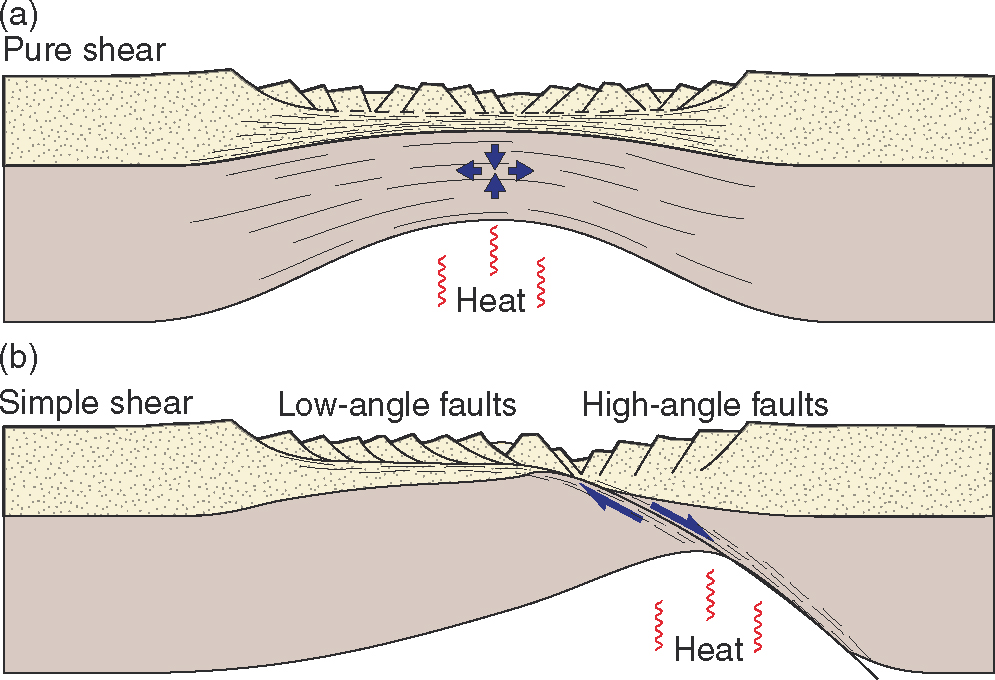 <!-- .element style="width:100%" --> </div> </div> <--o--> ## Normal Fault systems ### Metamorphic core complex 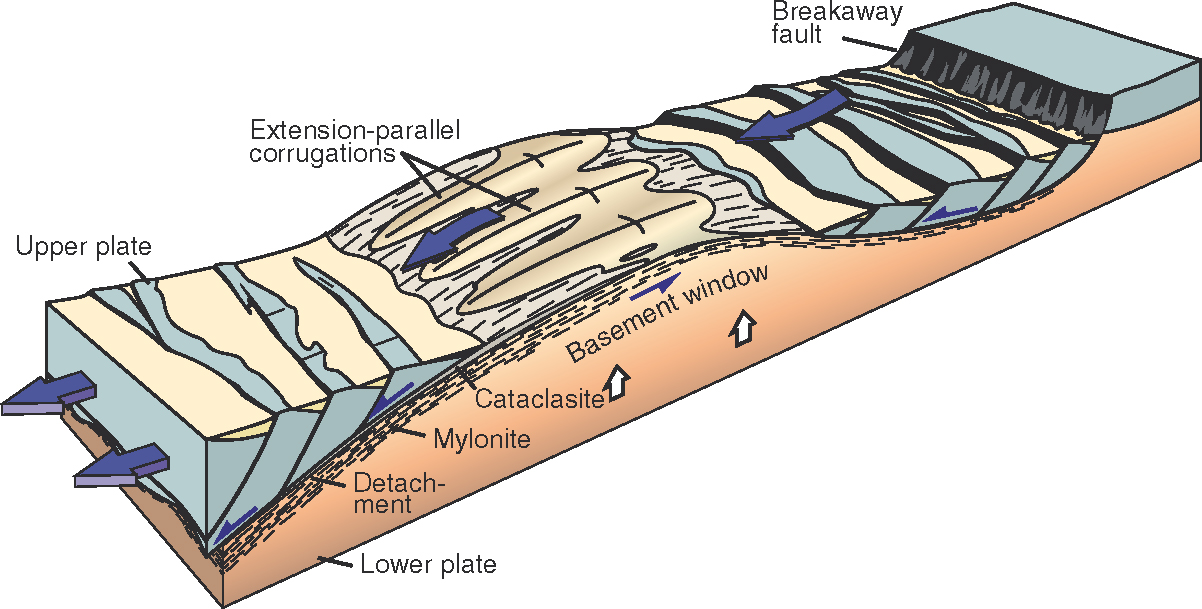 <!-- .element style="width:50%; float:right" --> Special simple shear case, common in extended areas During deformation the upper crust is thinned and Moho exhumed aided by erosion of the upper plate... <--o--> ## Extensional Settings ### Rift basins <div> <div style="width:50%; float:left; position:absolute; top:50%; transform: translate(0, -50%)"> - Active Rifting: Rift is generated by rising hot mantle plume in the asthenosphere. - Passive Rifting: Rift formed because of far-field stresses and tend to localise in region of weakenesses. *3 stages in Rifting: a) Early extension, creation or reactivation of fractures. Low-strain; b: Streching phase, faults developped; c) postrift: subsidence and sedimentation. Compaction.* </div> <div style="width:50%; float:right"> 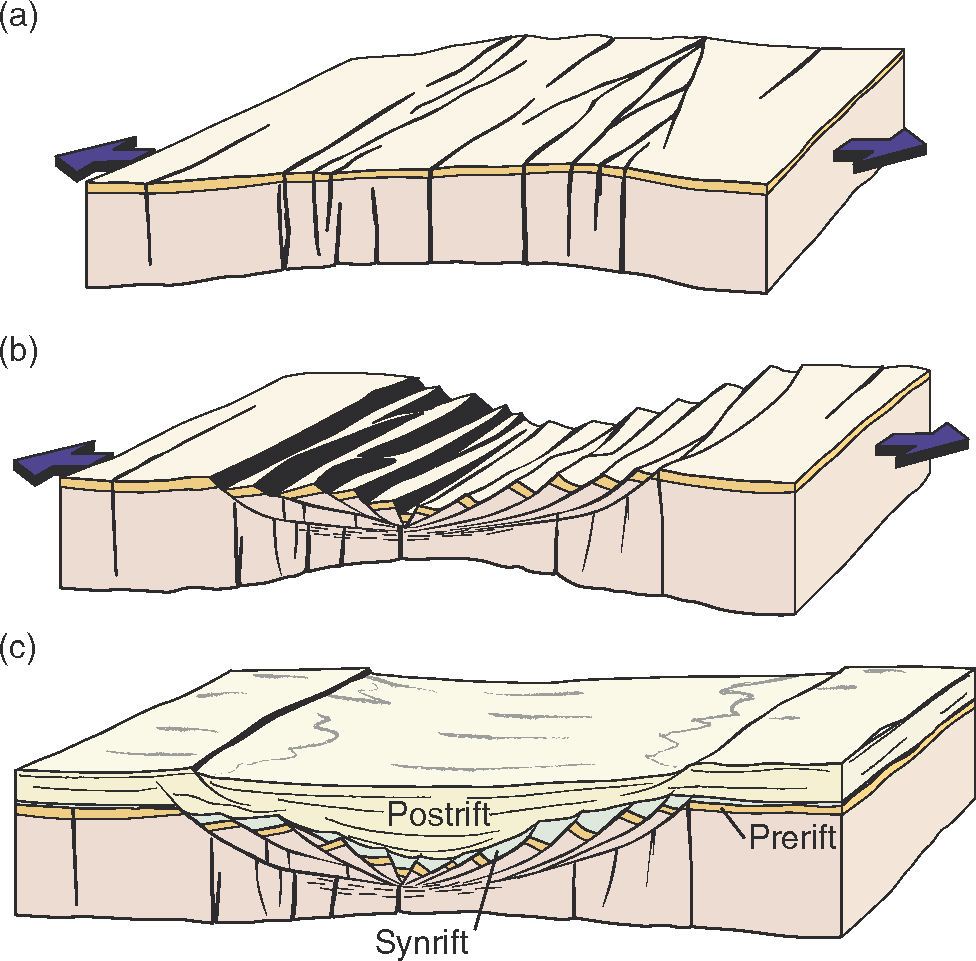 <!-- .element style="width:90%" --> </div> </div> <--o--> ## Extensional Settings ### Passive margins and oceanic rifts <div> <div style="width:50%; float:left"> Continental Rifting results in thinning of the crust and upwelling of hot asthenosphere. The release in pressure may result in partial melting and generation of basaltic magmas. New Lithosphere form at the margin during continental break up. The continental rift becomes inactive or "passive" at the margin. </div> <div style="width:50%; float:right">  <!-- .element style="width:100%" --> </div> </div> <--o--> ## Extensional Settings ### Extension in orogens: origin and occurences <div> <div style="width:40%; float:left; position:absolute; top:50%; transform: translate(0, -50%)"> Orogens are frequently associated with extension. Following the Wilson cycle, the orogen can be subject to extension, from oceanic spreading and subduction to continental collision and eventually orogen collapse. </div> <div style="width:60%; float:right">  <!-- .element style="width:100%" --> </div> </div> <--o--> ## Extensional Settings ### Extension in orogens: Himalayas <div> <div style="width:40%; float:left"> Interpretation: During the India-Asia collision, a slab of granitic composition and relatively low density decoupled from the subducting Indian Plate. The buoyant slab ascended towards the surface along a basal thrust zone (MCT). A Major normal fault developed along the top at the back of the chain. </div> <div style="width:60%; float:right">  <!-- .element style="width:100%" --> </div> </div> <--o--> ## Extensional Settings ### Extension in orogens: Himalayas <div> <div style="width:40%; float:left"> Interpretation: During the India-Asia collision, a slab of granitic composition and relatively low density decoupled from the subducting Indian Plate. The buoyant slab ascended towards the surface along a basal thrust zone (MCT). A Major normal fault developed along the top at the back of the chain. </div> <div style="width:60%; float:right"> 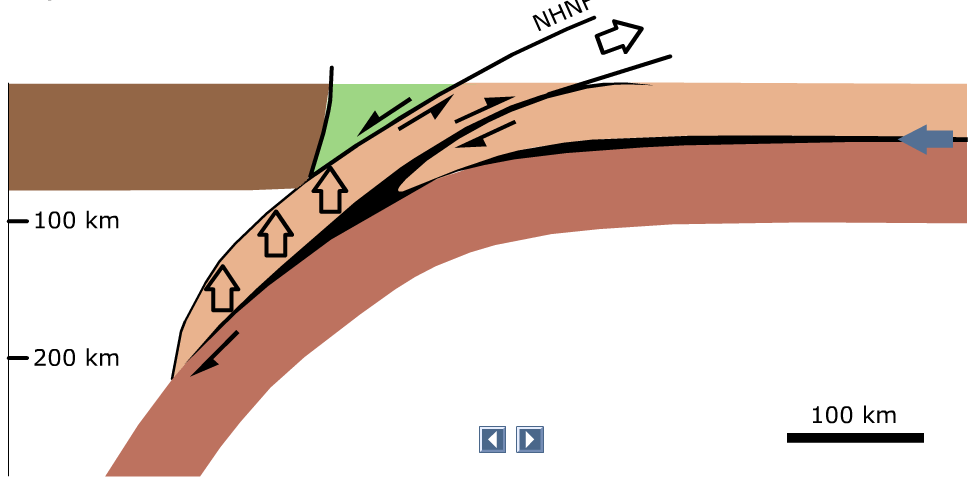 <!-- .element style="width:100%" --> </div> </div> <--o--> ## Extensional Settings ### Extension in orogens: Himalayas <div> <div style="width:40%; float:left"> Interpretation: During the India-Asia collision, a slab of granitic composition and relatively low density decoupled from the subducting Indian Plate. The buoyant slab ascended towards the surface along a basal thrust zone (MCT). A Major normal fault developed along the top at the back of the chain. </div> <div style="width:60%; float:right">  <!-- .element style="width:100%" --> </div> </div> <--o--> ## Extensional Settings ### Extension in orogens: Himalayas <div> <div style="width:40%; float:left"> Interpretation: During the India-Asia collision, a slab of granitic composition and relatively low density decoupled from the subducting Indian Plate. The buoyant slab ascended towards the surface along a basal thrust zone (MCT). A Major normal fault developed along the top at the back of the chain. </div> <div style="width:60%; float:right"> 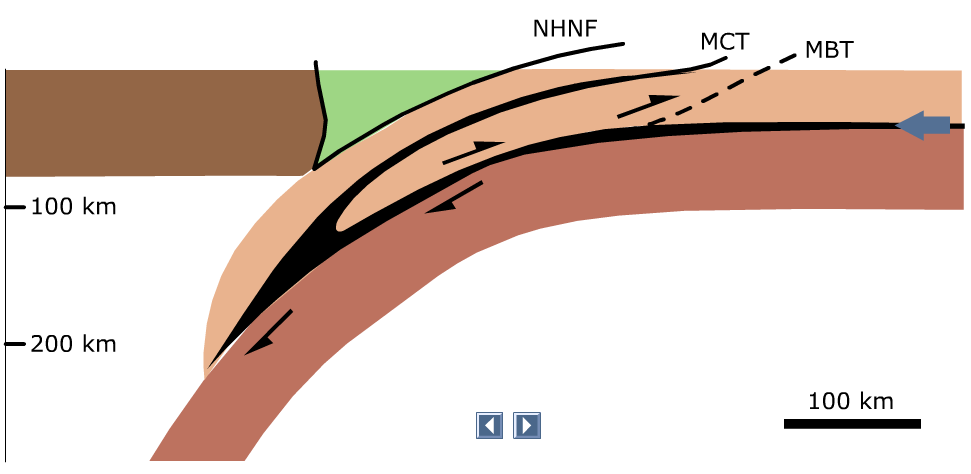 <!-- .element style="width:100%" --> </div> </div> <--o--> ## Extensional Settings ### Extension in orogens: Delamination Model <div> <div style="width:40%; float:left"> A relatively cold and dense root of an orogen detaches from the lithosphere and sinks down into the mantle. In response to **Isostatic** unloading the remaining lithosphere is exhumed. Tectonic displacement takes place along a base decollement from the hinterland towards the foreland an the upper part of the lithosphere experiences extension. </div> <div style="width:60%; float:right">  <!-- .element style="width:100%" --> </div> </div> <--o--> ## Extensional Settings ### Extension in orogens: Delamination Model <div> <div style="width:40%; float:left"> A relatively cold and dense root of an orogen detaches from the lithosphere and sinks down into the mantle. In response to **Isostatic** unloading the remaining lithosphere is exhumed. Tectonic displacement takes place along a base decollement from the hinterland towards the foreland an the upper part of the lithosphere experiences extension. </div> <div style="width:60%; float:right"> 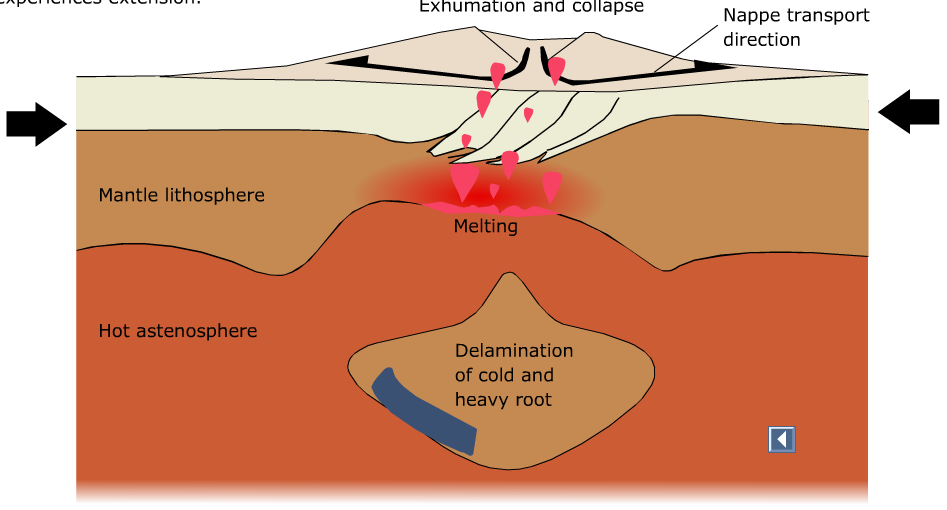 <!-- .element style="width:100%" --> </div> </div> <--o--> ## Extensional Settings ### Extension in orogens: Post-orogenic extension <div> <div style="width:40%; float:left"> The Caledonian orogen of Southern Norway features a number of major low-angle faults that formed in response to orogenic collapse and reversal of plate movements. </div> <div style="width:60%; float:right">  <!-- .element style="width:100%" --> </div> </div> <--o--> ## Extensional Settings ### Extension in orogens: Post-orogenic extension <div> <div style="width:40%; float:left"> The Caledonian orogen of Southern Norway features a number of major low-angle faults that formed in response to orogenic collapse and reversal of plate movements. </div> <div style="width:60%; float:right">  <!-- .element style="width:100%" --> </div> </div <--o--> ## Extensional Settings ### Extension in orogens: Post-orogenic extension <div> <div style="width:40%; float:left"> The Caledonian orogen of Southern Norway features a number of major low-angle faults that formed in response to orogenic collapse and reversal of plate movements. </div> <div style="width:60%; float:right">  <!-- .element style="width:100%" --> </div> </div <--o--> ## Summary - Extensional Faults extend a reference surface (surface of the crust or bedding fault smaller faults) - Large scale extensional systems can be modeled using a **soft domino model** which allows for internal deformation of the blocks. - Extensional Faults can form imbrications zones, duplexes and flat-ramps systems like contractional faults. - A **Metamorphic core complex** consists of metamorphic rocks exposed in a window and separated from overlying rocks by extensional detachments. - **Extensional faults** and **detachments** are commonly found in orogens. They form both during and after the collision. - Synconvergent **gravitational collapse** can cause extension in the hinterland and thrusting towards the foreland. - **Post-convergent extension** commonly reactivates thrusts and extensional detachments.